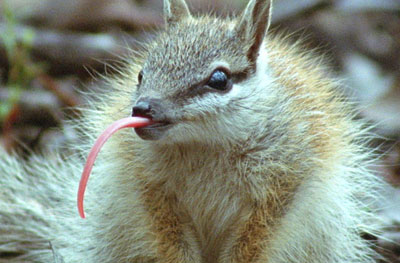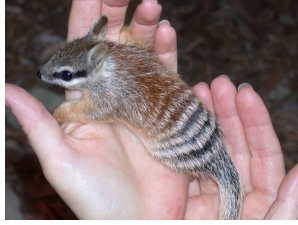Say farewell to the nightmare fuel from the deep sea abyss. We have tormented you with enough freaks to fill Davy Jones's locker. It's really about time that we did something cute, fuzzy, and on land. We owe you guys for those sleeping pills, right?
So, to make up for the mind-scarring, have a cute:

Wait. There's a horrible string attached to that cute, isn't there?
The creature above is called a numbat (Myrmecobius fasciatus). Before you all say "that sounds weird," it's native to Australia. At first glance, it looks like one of the less-deadly species in Australia, but remember how crazy Afrotheria got? If the scientists are right, the numbat's closest relative was the Tasmanian Tiger. (At least there's some family resemblance this time!) They are also (erroneously) called banded anteaters and are the only fully diurnal marsupials.
Numbats are one of Australia's least threatening creatures. They are 1-2 feet long, have no intention of eating other mammals, and would make better purse pets than a Chihuahua. Numbats have a fair amount of aerial predators (read: any bird of prey) and are eaten by carpet pythons as well. Just about the only things they are remotely threatening to are termites.

May the great Rainbow Serpent help you if you are a termite around a numbat. Numbats eat termites. Just termites. An adult numbat can eat up to 20,000 termites per day. They dig into the earth with those cute little claws, then use their sticky tongues to lap the buggers and gnash them with their teeth. Numbats even have their days scheduled around termites, much like some of us around TV schedules.
Numbats are, however, relatively rare. Unless you happen to have a termite mound in your Australian backyard, you probably will not see them at all. They were fairly abundant until European hunters came down under and unleashed red foxes upon the wild. By the 1970's, there were fewer than 1,000 individuals remaining in the wild. The best areas to see numbats today are in Western Australia.

Endangered species bumpers often cite major mammalian predators as 'warning signs,' but we think numbats deserve to stand out on that list, too. They're a prime example of what happens when non-native species are not kept in check. Maybe, if they ever get off the endangered species list, they will join sugar gliders, Children's pythons, budgerigars, and cockatiels as yet another adorable pet from Australia. You know you'd want one.
So, to make up for the mind-scarring, have a cute:

Wait. There's a horrible string attached to that cute, isn't there?
The creature above is called a numbat (Myrmecobius fasciatus). Before you all say "that sounds weird," it's native to Australia. At first glance, it looks like one of the less-deadly species in Australia, but remember how crazy Afrotheria got? If the scientists are right, the numbat's closest relative was the Tasmanian Tiger. (At least there's some family resemblance this time!) They are also (erroneously) called banded anteaters and are the only fully diurnal marsupials.
Numbats are one of Australia's least threatening creatures. They are 1-2 feet long, have no intention of eating other mammals, and would make better purse pets than a Chihuahua. Numbats have a fair amount of aerial predators (read: any bird of prey) and are eaten by carpet pythons as well. Just about the only things they are remotely threatening to are termites.

May the great Rainbow Serpent help you if you are a termite around a numbat. Numbats eat termites. Just termites. An adult numbat can eat up to 20,000 termites per day. They dig into the earth with those cute little claws, then use their sticky tongues to lap the buggers and gnash them with their teeth. Numbats even have their days scheduled around termites, much like some of us around TV schedules.
Numbats are, however, relatively rare. Unless you happen to have a termite mound in your Australian backyard, you probably will not see them at all. They were fairly abundant until European hunters came down under and unleashed red foxes upon the wild. By the 1970's, there were fewer than 1,000 individuals remaining in the wild. The best areas to see numbats today are in Western Australia.

Endangered species bumpers often cite major mammalian predators as 'warning signs,' but we think numbats deserve to stand out on that list, too. They're a prime example of what happens when non-native species are not kept in check. Maybe, if they ever get off the endangered species list, they will join sugar gliders, Children's pythons, budgerigars, and cockatiels as yet another adorable pet from Australia. You know you'd want one.



Arkive.org has some videos. Most are very short.
ReplyDeleteNeat, I didn't know sugar gliders were from australia too.
ReplyDelete